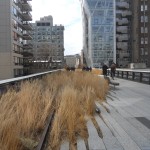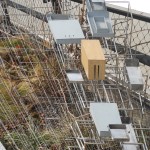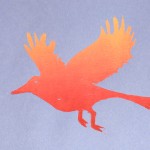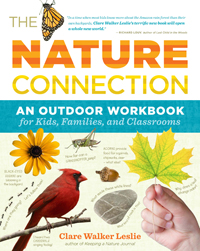We are at the end of another jam packed year at OISE, so in amongst the classes, field trips and papers, I was very happy to have some time with children to work on a collaborative art project together.ô ICS artô teacher Tara Rousseau generously opened her classroom to me again this year, this time with her grade three class.ô MA student Jennifer Ford-Sharpe also volunteered to help; she was central to the planning and implementation of the project.ô As learning about First Nations peoples is in the gr. 3 social studies curriculum, we used our new Aboriginal Education garden at OISE as the starting point. The students visited the garden in the fall to learn about native plant species and their role in aboriginal culture in Canada, and they made drawings of the plants in situ.ô Back in the classroom they learned about the importance of the four cardinal directions in First Nations cultures, and were inspired by the work of artists Christi Belcourt (Metis), Bill Reid (Haida), Jane Ash Poitras (Cree), and Carl Beam (Ojibway).ô This led the children to work on their own multi-media artworks using paint, clay, photographic transfers, and poetry.ô Their works centred on the importance of the cardinal directions in aboriginal culture and the connections between humans, wildlife, and plants.ô Such rich environmental learning!ô A few photos of the results are below, with more on the OISE website, found here:ô http://www.oise.utoronto.ca/ese/ESE_in_Practice/Eco-Art_Projects.html
Thanks to Tara and Jennifer for their partnership in facilitating this wonderful eco-art project!
Growing in New Directions
Turning Over a New Leaf
How can you help your students turn over a new leaf when it comes to living more sustainably on the earth?ô I asked my pre-service students to do just that this year, and not surprisingly they gave a range of responses, from recycling to upcycling, to doing more with less, to hatching new ideas.ô This inspired their latest eco-art project, which has just been installed at OISE.ô I introduced them to the field of eco-art in a workshop, and then together we created over a hundred clay leaves that capture their ideas in both text and image, which were glazed and fired.ô Working with artist/student Angela Johnson, we created a large metal branch on which to hang the vibrant leaves.ô As this work hangs in our stairwell as part of the Take the Stairs energy conservation campaign, we hope that Turning over a new Leaf will help others think about how they can take positive change towards sustainability in their lives and those of their students, one step at a time!
Next Gen of Eco-art Educators
Itãs conference season, and I was lucky to attend NAEA at the end of March – a good reason to get out of the grips of a harsh winter here in Toronto.ô The best part is learning about what other educators and artists are doing, and this year was no exception.ô Two up and coming educators made an impression on me with their enthusiasm and experiments into eco-art education, and it was a pleasure to meet them in person at NAEA for the first time.ô One is Jamia Weir (in a photo with me below), who is using her West Hollywood classroom to do her graduate research into eco-art ed, experimenting with eco-fashion design and art in school gardens.ô The second art educator is Jennifer Sams, a photographer and educator in Georgia ã she has a great website with lots of resources and eco-artists listed for easy reference.ô Check it out at:ô http://greenarted.weebly.com/eco-artistsenvironmental-artists1.html ô Jennifer has a Pinterest board going on eco-art, as do I ã Iãm finding it to be an excellent way of maintaining a set of visual inspirations for sharing with pre-service students; this digital tool is well-worth using to start your own board!
Cape Farewell moves to Toronto
Toronto has been the site of an innovative project on climate change and sustainability this fall, organized by the team at Cape Farewell [http://www.capefarewell.com/]. Started up by artist David Buckland in 2001 as a way to bring artists and scientists together to address climate change, Cape Farewell uses ãthe notion of expedition – Arctic, Island, Urban and Conceptual – to interrogate the scientific, social and economic realities that lead to climate disruption, and to inspire the creation of climate focused artã (from their website).ô The variety of projects this group has created internationally is fascinating, from trips to the Arctic, to art/science exhibitions, books, websites, performances and other cultural events.ô ô The Cape Farewell Foundation now has a Toronto office, which has led to a months-long cultural festival focused on climate change, and culminates in a conference here in February.ô For more on the range of events that they are hosting, visit http://www.capefarewellfoundation.com/projects/carbon-14.html
TED Talks on Environmental Art-making
Iãve been finding some great TED talks related to environmental art-making that I wanted to share:
Natalie Jeremijenko is a prof at NYU, and runs something she calls the ãEnvironmental Health Clinicã which features ãcreative health solutionsã for the environment.ô Her art projects are certainly creative, sometimes digital and often humourous ã well worth viewing.ô
Bjarke Ingels is a Danish architect who designs buildings that have a naturalistic design with stunning views – and perform nature-like functions to make them sustainable.
Canadian artist Edward Burtynsky won the 2005 TED prize for his large scale photos of some of the worldãs most challenging environmental issues, from quarries in Italy, to shipyards in Bangladesh, to the tar sands in Canada.ô
Margaret Wertheim works with her sister Christine to raise awareness about the environmental challenges facing the worldãs coral reefs, achieved through an interdisciplinary, interactive project that uses math, biology, and crocheting.
Iãm sure there are others, but these are my favourites so farãÎinspiring takes on what can happen when you bring creativity and environmental activism together!
The High Line is a Highlight!
Iãm still thinking about my trip to New York in March ã itãs such a wonderful city to inspire thought and action.ô One of the fondest memories I have taken away from it was my trip to the High Line, a new public park that sits on an old raised railway line on the west side of Manhattan.ô It runs from Gansevoort Street in the Meatpacking District to West 34th Street, between 10th & 11th Avenues.ô On it you find the old train rails interspersed with plantings, eco-artworks, benches, and amazing views of the neighbourhoods that surround it.ô Itãs an entirely unique way to experience NYC as you are raised above but still part of the fabric of the city.ô Below are photos of just two of the artworks that have been beautifully immersed into the parkãs design.ô The stained glass piece is by Spencer Finch, who was inspired by the colours of the nearby Hudson River; the amazing birdhouses are by artist Sarah Sze.ô If youãre in Manhattan, a visit to the High Line is a must ã just as inspiring as visiting the galleries!ô For more info, visit:ô ô
Causing a FLAP with eco-art!
Just finished an eco-art project with my students at OISE I wanted to share.ô A team of B.Ed students headed up by Raysha Carmichael, Michelle Attard and Sindy Lui led the FLAP eco-art project to help raise awareness of the challenges of bird deaths around high buildings in the city.ô Over 300 handmade bird prints were created and distributed to all of the OISE offices with windows, reminding faculty and staff to do their part.ô The prints act as an artistic reminder for people to close their office blinds each night, as well as turn off overhead office lights and use task-focused lighting at night.ô Faculty and staff were in quite a flap about the prints ã they loved them! ô (We didnãt mention that turning off their lights and closing blinds are also great energy conservation measuresãÎ) Just goes to show that eco-art activism can be a wonderful way to get people on board with a project ã far more effective than a memo or flyer!ô For more info on the project, hereãs the link:
Get outside and draw!
I had the pleasure recently of attending a workshop led by naturalist Clare Walker Leslie, who is a prolific artist and author.ô Clare is a passionate proponent of art-based nature journalling, well-evidenced in her many journals.ô Seeing her journals is a delight ã they are rich with drawings of the natural world, observations, and connections to her experiences.ô Her drawing style is beautiful ã in some cases, quick and gestural to capture the shape of a bird before it flies off into the bush; in others, detailed, well-worked watercolours or coloured pencil drawings created in her studio from outdoor sketches and field guides.ô She spends a lot of time in classrooms with students, encouraging them to use drawing (or mark-making, as she prefers to call it) as a way to closely observe the flora and fauna around them ã an important step towards developing their ecological literacy.ô Clare delivered three workshops in Toronto, including one at the Master of Teaching Environmental Education conference at OISE.ô It was refreshing to get outside ã yes, even in a cold Ontario winter ã just to draw, and to be reminded of the power of journaling as an ongoing learning activity for learners of all ages. ô For more info on Clare, or to order one of her books, please visit her website at:ô ô
Maybe there’s something in the water in BC…
I had the pleasure of catching up with Lisa Lipsett recently, an artist from Salt Spring Island (on the West Coast of Canada) who is doing some fascinating work as an artist and educator in connecting to nature through art-making.ô (There seems to be lots of environmental art happening in British Columbia – may it’s all that makes for such fertile ground!)ô Sheãs designed a process she calls Creative Nature Connection, that is, in her words ãa nature-inspired practice of artful connection to ourselves, each other and the world.ãô This is more than simply art-making in the great outdoors, but involves connecting to the self and with nature by ãletting the inside out, and letting the outside in.ãô Sheãs written a book about this called Beauty Muse: Painting in Communion with Nature, and runs programs and workshops around the country as requested.ô She also has a terrific website, well-worth a visit to learn more about her approach.ô Find it at:
Another Inspiring Artist
ô
As Iãm on a roll with introducing wonderful artists, another one Iãd like to share is Alice Vander Vennen from Cobourg, Ontario.ô For those of you who might be interested in learning how to incorporate natural and found materials into your own practice, she is an inspiring artist and teacher ã with workshops coming up this summer!ô I love her work ã she weaves together textiles, clay, stones, found objects, wire, metal and branches, amongst other things, into her abstract pieces.ô Iãm not sure she would classify herself as an environmental artist, but in so many ways she integrates ideas around nature, culture, and sustainability through her choice and use of materials.ô (Iãm including one of her pieces here, which I donãt think sheãll mind as I just bought it!)ô Please check out her website at:
 ô ô
ô ô 












